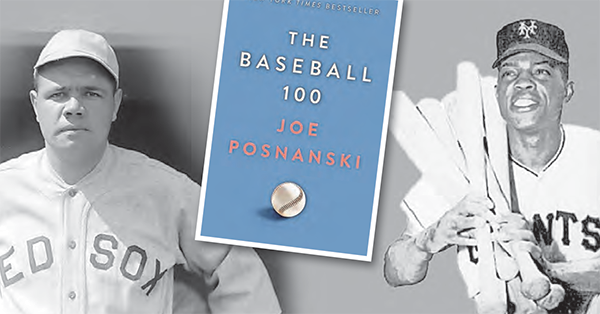
As MLB teams report to spring camp, we’re once again celebrating the great sport of baseball — America’s pastime. Spring means new life, so therefore, spring training means a rebirth of optimism ahead of another season — especially for us New York Mets fans.
To celebrate spring training, I’d like to inform the reader of a mesmerizing baseball book that I just finished: “The Baseball 100,” written by Joe Posnanski.
This book was supposed to be my summer reading for 2022. Yet at more than 830 pages and with nearly 300,000 words, three summer months was not nearly enough to absorb this massive yet extremely compelling undertaking.
Recommended to me by baseball fanatic and pastor emeritus at Good Shepherd, Marine Park, Father Jim Devlin, the book is the ultimate tour of baseball history through the game’s greatest heroes. It’s an instant classic of baseball literature and a must-read for any die-hard fan.
Posnanski, a veteran sportswriter and New York Times bestselling author, tells in-depth stories about his top 100 players of all time that even the most devout baseball fans wouldn’t know. The research is nothing short of epic.
Just as spring training celebrates baseball, this book celebrates the true titans of the game: Tony Gwynn, Sandy Koufax, Pete Rose, Joe DiMaggio, Bob Feller, Nolan Ryan, Ken Griffey Jr., Bob Gibson, Jackie Robinson, Yogi Berra, Tom Seaver, Roberto Clemente, George Brett, Johnny Bench, Rickey Henderson, Albert Pujols, Frank Robinson, Mike Schmidt, Lou Gehrig, and Mickey Mantle — just to name a handful.
What’s fascinating is that within his countdown, Posnanski includes many forgotten players who played in the Negro Leagues during a time of segregation: Josh Gibson, Cool Papa Bell, Pop Lloyd, among others. Even Japanese power-hitting sensation Sadaharu Oh made the list.
As for the vaunted top 10, here’s a quick look: No. 10 Satchell Paige, No. 9 Stan Musial, No. 8 Ty Cobb, No. 7 Walter Johnson, No. 6 Ted Williams, No. 5 Oscar Charleston, No. 4 Henry Aaron, No. 3 Barry Bonds, No. 2 Babe Ruth, and No. 1 Willie Mays.
While Posnanski welcomes debate among his list, most baseball fans would likely arrive at Ruth and Mays in some combination of the top two rankings of all time. Ruth was this larger-than-life legend who we know mainly through stories and statistics. Mays though remains a vivid memory for scores of baseball fans, especially those who saw him during his heyday with the New York/San Francisco Giants.
“Mays did everything well,” Father Devlin said. “He was a great fielder who played a premier position. He had a great arm, and he was a great hitter who hit for power and average. And he was the greatest baserunner I ever saw. He was by far the best player I ever saw.”
No one would question how Ruth — the Great Bambino, the Colossus of Clout, the Sultan of Swat — revolutionized the game. There were seasons where he as an individual hit more home runs than entire franchises! What we often forget was how dominant of a pitcher he was early in his career.
There’s just something though about Mays — the “Say Hey” Kid — that makes this No. 1 ranking the perfect fit. A five-tool player with his longevity and consistency is truly a one-in-a-million talent — not to mention his character.
That character was on full display during the fall of 1979 — the same year Mays was inducted into the Baseball Hall of Fame. The Regina Athletic Association based in Bensonhurst held its fall sports award dinner for boys’ baseball and girls’ softball at Xaverian H.S., Bay Ridge, and Mays appeared as a special guest speaker.
John Shea, a 1969 graduate of Bishop Ford H.S., Park Slope, managed one of the softball teams and remembers being excited to meet Mays in person. He was only a small child during the 1954 World Series, but he’s confident that Mays’ catch in deep center field at the Polo Grounds lives on as an enduring highlight.
“I don’t doubt that his catch was the best catch in the history of baseball,” Shea said. “He had to run so far, and in any other park in baseball, that would have been a home run.”
Mays answered questions before the award ceremony, and then, as Shea recalled, he asked the coaches to tell him something unique about each player so that he could properly congratulate them as he handed them their awards.
What a thrill that had to be for both the players and, more so, their parents. Here’s a professional athlete who hit 660 big-league home runs, made what many call the greatest catch in MLB history, and who had just received baseball’s highest honor taking the time with a group of youth athletes.
Of course, this anecdote does not serve as the tiebreaker between Mays and Ruth. In fact, as Posnanski points out, ranking the top 100 baseball players of all time assuredly invites debate, disagreement, and dispute. It’s the journey and the celebration of the game through the book that’s so entertaining.
“It’s a hidden gem,” Father Devlin said. “It was the best baseball book I’ve ever read.”
And I would agree: It’s the best baseball book I’ve ever read.
Contact Jim Mancari via email at jmmanc@gmail.com.
